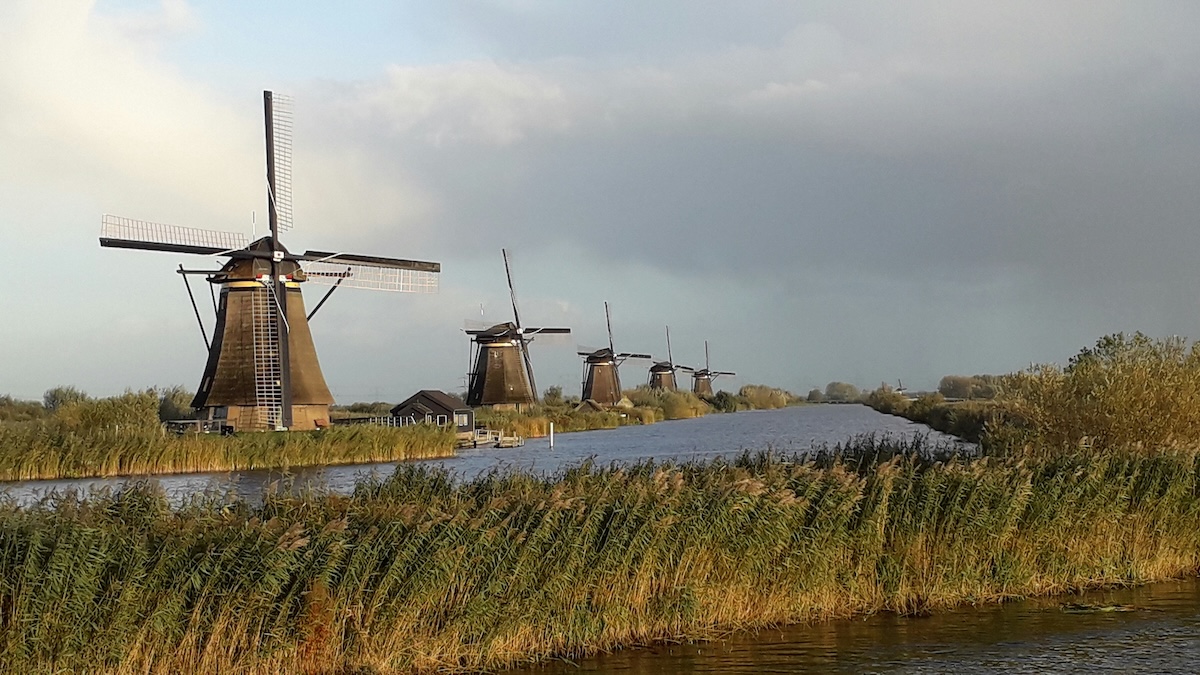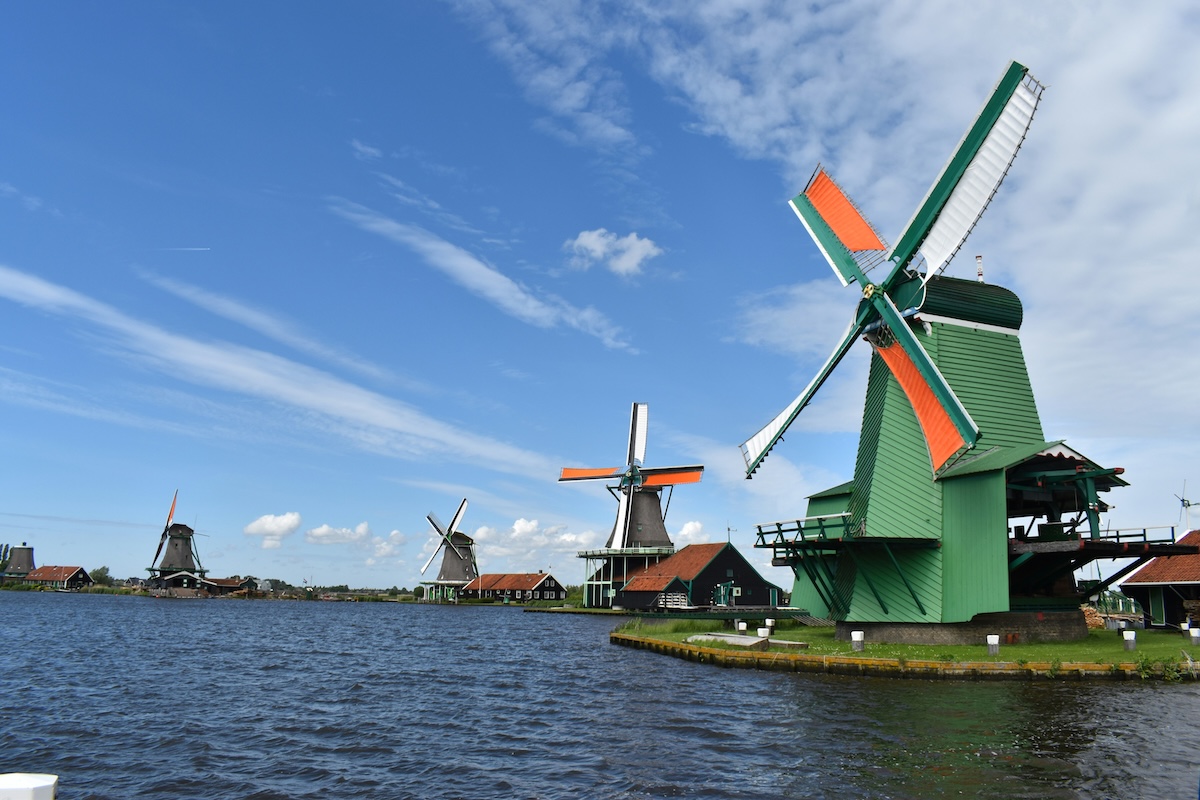
Why Are the Netherlands’ Windmills Perfectly Positioned for Instagram?
By: Sarah Stone
Skip to Section
Those perfectly aligned windmills you see on Instagram feeds didn’t just happen to form photogenic rows by chance. Long before social media influencers discovered the picture-perfect views at Kinderdijk and Zaanse Schans, Dutch engineers created what would become some of the world’s most photographable landscapes.
When you see those classic Dutch scenes—a neat row of windmills with their sails turning against a blue sky, perhaps with a few tulips in the foreground and a canal reflecting the whole scene—you’re looking at 700 years of practical problem-solving that accidentally created a social media paradise.
Engineering First, Aesthetics Second

Windmills at Kinderdijk – photo by Tjaako Minnema on Unsplash
The Netherlands has always fought a battle against water—about a quarter of the country lies below sea level. Without human intervention, much of the Dutch landscape would be underwater.
Starting in the 13th century, the Dutch began building windmills to pump water from low-lying areas into canals and rivers that would carry it away to the sea. These early drainage mills made it possible to reclaim land from lakes and marshes, creating the famous polders (pieces of land reclaimed from the sea) that define much of the Dutch landscape today.
Engineers placed the windmills in neat, geometric patterns along dikes and canals not for beauty, but for maximum efficiency. At UNESCO World Heritage site Kinderdijk, over a dozen windmills stand in perfect formation along canals. This practical arrangement created what photographers call “leading lines”—a row of similar objects that draws the eye through an image.
Similarly, at Zaanse Schans, where green windmills cluster along the Zaan River, the arrangement came from industrial logic. These mills weren’t for water drainage but for industrial production—sawing wood, making paper, grinding spices, and pressing oil. They clustered along the river for easy transportation of materials. Unlike windmills in other countries that might stand alone on hills, Dutch mills often stand in groups, creating compositions that feel deliberately arranged. This clustering creates what photographers call the “rule of odds”—groups of three, five, or more similar objects that naturally please the human eye.
The windmills found throughout these areas of the Netherlands follow similar patterns because tried-and-tested designs work best. The octagonal shape, thatched body, and wooden sails were all engineering solutions, not artistic choices. Even the colors weren’t chosen for their aesthetic qualities. The famous white, green, and brown color schemes were based on available paints and preservatives. The white lime wash protected the brick or wood, while brown tar preserved the wooden bases against water damage.
By the early 20th century, most Dutch windmills had become pretty much obsolete. Electric pumps and modern industry had replaced wind power, and many mills fell into disrepair.
A growing sense of cultural heritage saved these structures; windmills represented an important part of Dutch national identity and history.
Organizations like De Hollandsche Molen (The Dutch Mill Society), founded in 1923, have worked to preserve and restore historic windmills. Local governments designated protection zones around significant mill sites, preventing modern development from spoiling the historic views.
This preservation happened long before mass tourism or social media, but it inadvertently created perfect conditions for today’s photography-driven travel culture. Unlike many historic landscapes that have been altered by modern development, Dutch windmill sites often look remarkably similar to how they appeared centuries ago.
Today, the economic value of these windmills comes from tourism.
Local tourism boards have leaned into this appeal. Visit the Netherlands’ official tourism website, and you’ll find suggested photography spots and tips for visiting the windmills. Head to a gift shop and you’ll find miniature windmills, postcards, and photo books showcasing these iconic views alongside the famous Dutch tulips, clogs, and stroopwafels.
Planning Your Netherlands Windmill Photography Trip

Green windmills at Zaanse Schans – photo by Enes Dincer on Unsplash
The windmills perform so well on social media because they combine cultural and natural elements in one frame. If you want both history and natural beauty in your photos, Dutch windmill landscapes deliver both.
- Time your visit for spring, when you might catch windmills with tulip fields, or fall, when morning mist sets up gorgeously atmospheric scenes.
- Try taking photos during different parts of the day; the Netherlands is famous for its changeable skies, with perfect blue quickly giving way to gray clouds.
- Visit Kinderdijk early on weekday mornings to avoid crowds. The site opens at 9am, but photographers usually arrive earlier to set up along public paths outside the official entrance.
- Check the turning days for windmills at Zaanse Schans. While the site is accessible daily, you may want to see the windmills in operation.
- Consider less-famous alternatives like the windmills at Schermerhorn or individual mills scattered throughout North and South Holland provinces.
- Bring a polarizing filter for your camera to cut glare and enhance the reflections of the canal waters.
- Take photos during the golden hour, when the sails are backlit against the setting sun.
- Allow plenty of time. The best windmill photos come from waiting for the right light, a break in the clouds, or a moment when the crowds thin out.
Have you visited the famous Dutch windmills? What advice would you give to fellow travelers? Share your stories and tips with the Frayed Passport community!
About the Author
 As the editor-in-chief of Frayed Passport, my goal is to help you build a lifestyle that lets you travel the world whenever you want and however long you want, and not worry about where your next paycheck will come from. I've been to 20+ countries and five continents, lived for years as a full-time digital nomad, and have worked completely remotely since 2015. If you would like to share your story with our community, or partner with Frayed Passport, get in touch with me using the form on our About page.
As the editor-in-chief of Frayed Passport, my goal is to help you build a lifestyle that lets you travel the world whenever you want and however long you want, and not worry about where your next paycheck will come from. I've been to 20+ countries and five continents, lived for years as a full-time digital nomad, and have worked completely remotely since 2015. If you would like to share your story with our community, or partner with Frayed Passport, get in touch with me using the form on our About page.Featured image by Marcel Schachinger on Unsplash
Information published on this website and across our networks can change over time. Stories and recommendations reflect the subjective opinions of our writers. You should consult multiple sources to ensure you have the most current, safe, and correct details for your own research and plans.
Frayed Passport is a participant in the Amazon Associates Program, an affiliate advertising program designed to provide a means for sites to earn advertising fees by advertising and linking to Amazon.com. We also may share links to other affiliates and sponsors in articles across our website.




